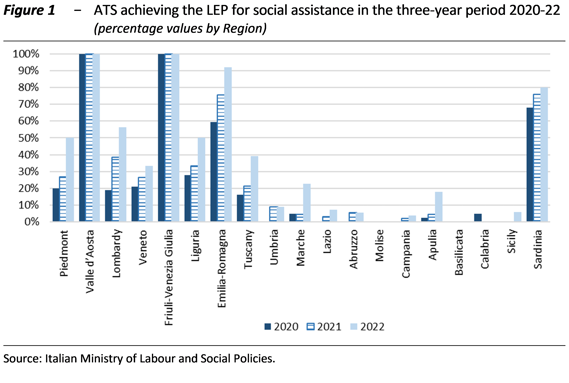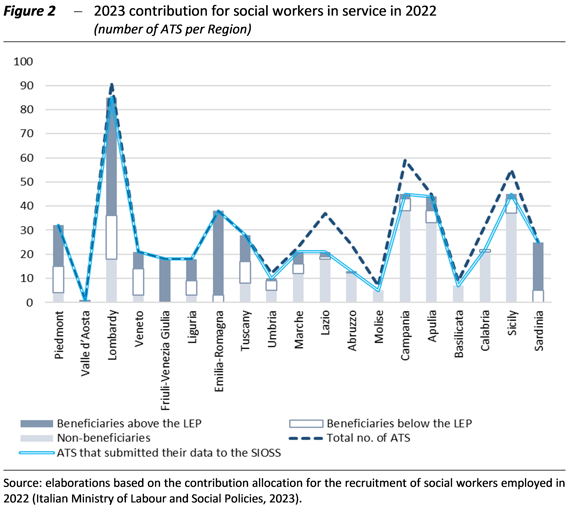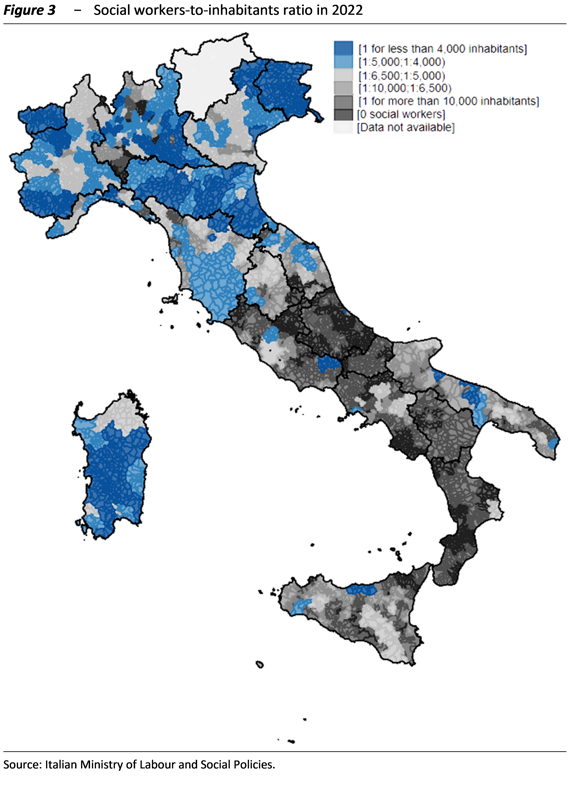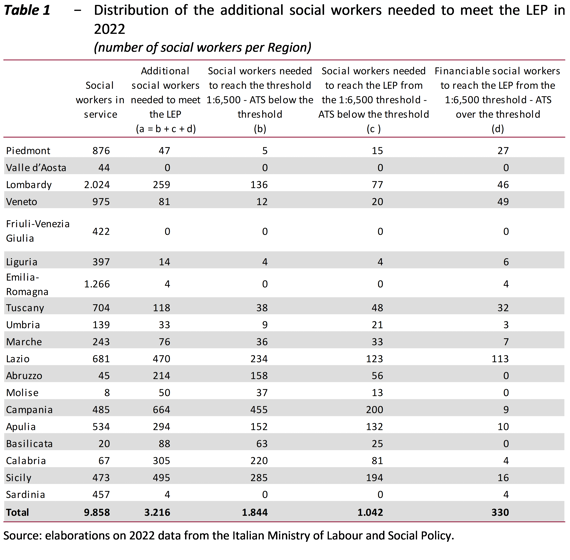Implementation of the Essential Level of Benefits for Social Assistance: Recruitment of Social Workers
The Parliamentary Budget Office (PBO) has published a Focus Paper on the recruitment of social workers as part of the implementation of the Essential Level of Benefits (Livello essenziale delle prestazioni, LEP) for social assistance defined in the 2021 Italian Budget Law. The topic provides an interesting case study both in terms of the role that qualified personnel play in ensuring that territories are able to provide social services, and because different levels of government – individual municipalities and the social districts (ambiti territoriali sociali, ATS) they belong to, Regions and the State – overlap to guarantee that the LEP is provided.
Starting from the institutional framework governing the management of social services, the PBO Focus Paper examines the two separate funding mechanisms of the LEP for social assistance and analyses the numbers of social workers in the territories and their evolution since the introduction of the LEP. Furthermore, considering the territorial gaps present when it comes to the LEP, the paper highlights some critical issues that hinder the full implementation of the LEP and provides some general considerations.
Context
The 2021 Budget Law provided as a LEP for the presence in each ATS of one social worker for every 5,000 inhabitants, with the aim of reaching a more advanced service target (obiettivo di servizio) of one social worker for every 4,000 inhabitants (Law 178/2020). The funding mechanism to guarantee this LEP consists of two distinct measures – the contribution for the recruitment of social workers in the National fund for combating poverty and social exclusion (Poverty Fund)¹ and the funding of service target for the strengthening of municipal social services in the Municipal solidarity fund (FSC)² – having very different methods of resource allocation, monitoring and reporting.
An analysis of the interaction between the different funding mechanisms revealed critical issues both regarding the actual functioning of the reinforcement mechanisms for the implementation of the LEP throughout the country and the coherence of the process for implementing fiscal federalism.
In particular, the contribution from the Poverty Fund for the recruitment of social workers, amounting to EUR 180 million, is allocated to those ATS already having at least one social worker every 6,500 inhabitants and is paid out in reimbursement of the expenditure incurred for the workers in service in the previous year. The other funding channel is made up of the resources that individual municipalities receive through the FSC, with funds (EUR 764 million as of 2030 for the municipalities of the Regions with ordinary statutes (RSO) and of Sicily and Sardinia) earmarked for strengthening social services, which the municipalities can use to allow their ATS to reach the minimum threshold of one social worker every 6,500 inhabitants by 2026.
Three years have passed since the introduction of the LEP for social assistance. Since then, subsidies for the recruitment of social workers have been disbursed twice, amounting to approximately EUR 50 million in 2022 and EUR 64.8 million in 2023, and resources for the strengthening of municipal social services from the FSC have been disbursed in three tranches, amounting to EUR 216 million for the municipalities in the RSOs in 2021 and EUR 299 million and EUR 351 million for the municipalities in the RSOs, Sicily and Sardinia in 2022 and 2023, respectively.
In 2022, municipalities belonging to ATS below the threshold (less than one social worker every 6,500 inhabitants) received additional resources of approximately EUR 114 million. For the majority of these ATS, the FSC resources allocated to each municipality belonging to the ATS to improve social services already in 2022 appeared to be sufficient to recruit the staff needed to reach the threshold of one social worker every 6,500 inhabitants.
Impact of the measures in the first two years of application
Two years after the introduction of the LEP, 1,688 new social workers were registered, with a very gradual increase compared to the overall resources available and not enough to remedy the existing inequality between territories with regard to the LEP. As a result of this increase, the number of ATS reaching the LEP increased in almost all the Regions (Figure 1). However, in the majority of the ATS in Veneto and in the Regions of the Centre and South of Italy (except Sardinia), the social workers-to-inhabitants ratio remained below the essential level.

Of the 499 ATS that submitted their data to the Information system of social supply and services (Sistema Informativo dell’offerta dei Servizi Sociali, SIOSS) in order to obtain the 2023 contribution for the year 2022, 224 did not benefit from the contribution as they had an insufficient number of social workers compared to the entry threshold (Figure 2). The highest percentage of non-beneficiaries, as a share of the total number of ATS at the regional level, was recorded in the Regions of Southern Italy.

89 ATS received resources which were not yet sufficient to reach the LEP. The remaining 186 ATS, which met the LEP, received funding both for the workers exceeding the threshold of one worker every 6,500 inhabitants and up to the LEP (one in 5,000), and for those serving to reach the target of one worker per 4,000 inhabitants. Such ATS are frequently found in the Northern Regions, Sardinia and Tuscany.
Requiring a minimum number of workers to be eligible for the contribution reduced the scope of the intervention. A large part of the resources allocated to date for the LEP has not been used, despite the high number of understaffed ATS, while ATS that had already reached the LEP have been financed. Compared to the total number of social workers financed with the contribution in 2023, 37 per cent of them allow the ATS to aim for the goal of one worker per 4,000 inhabitants, exceeding the LEP.
Recruitment of social workers still needed to reach the LEP
Following the increase by 1,688 social workers between 2020 and 2022, the number of ATS reaching the LEP has increased in almost all Regions. However, the social workers-to-inhabitants ratio remains below the essential level in most of the ATS in Veneto and the Central and Southern Regions (except Sardinia).
The distribution of the ATS, below and above the LEP, is also very uneven within the individual Regions. For example, in Valle d’Aosta and Friuli-Venezia Giulia, not only did all the ATS reach the LEP in 2022, but most of them have much higher staffing levels (one social worker per less than 4,000 inhabitants). Most of the Regions have a less uniform distribution, with well-structured areas and others seriously lacking (Figure 3).

In the Southern Regions, the number of social workers is very low (only Sardinia has more favourable levels): on average, there is one social worker for more than 10,000 inhabitants. However, the data from the Italian Ministry of Labour and Social Policies only include staff with an open-ended contract, since this is the funded population, and therefore the gap with the LEP could be overestimated if municipalities or ATS had employed social workers under other forms of contract.
The number of additional social workers needed to reach the LEP in all the ATS is 3,216, taking into account the ATS present in 2022 and their workers (net of the Trentino-Alto Adige areas) and assuming the absence of social workers in the areas that have not reported data to the SIOSS.
This figure can be broken down as follows: 1,844 workers to be hired in 291 ATS below the threshold, for which approximately EUR 73.7 million would be needed (to be found by drawing on the resources of the FSC for the development of social services); 1,042 workers, for a cost of about EUR 41.7 million, that the same 291 ATS will be able to hire, once they exceed the threshold, with the resources of the contribution from the Poverty Fund; 330 workers to be hired again with the resources of the contribution from the Poverty Fund in the 97 ATS over the threshold that already have access to this funding, with a cost of EUR 13.2 million (Table 1).

Funding mechanisms: critical issues
Despite the availability of resources, the increase in the number of social workers appears to be very gradual and most of the recruitment still needed is concentrated in the ATS below threshold. The peculiar funding mechanism, whereby recruitments in those ATS can be made using the resources for municipal service target and, in the next phase, the Poverty Fund contribution, could be an obstacle to the implementation of the LEP.
Firstly, the service target of one worker every 6,500 inhabitants (provided for in the 2022 Budget Law) still does not have to be compulsorily reported by the municipalities. As a result, out of 114.2 million resources allocated to the local authorities of the understaffed ATS under the municipal service target funding, 63.9 million were to be reported.
Secondly, under the current state of the service target reporting rules for the understaffed municipalities, the hiring of social workers is only one of the available allocation options, and there are no sanctions for failure to implement the LEP, other than the ATS in question forfeiting the Poverty Fund contribution.
Moreover, the way in which the service targets are to be reported does not require that workers are necessarily hired on permanent contracts, while the grant only finances permanent staff. This means that any worker hired by municipalities with a fixed-term contract will only be able to contribute at ATS level towards exceeding the threshold for Poverty Fund contribution after becoming a permanent member of staff. In this regard, it should be noted that the LEP for social assistance definition does not indicate the contractual form under which social workers are to be employed.
In addition to the fact that the two funding schemes consider a different annual cost per social worker (respectively, 40,000 and 50,000 euro per year for each permanent worker), the rules for monitoring and reporting on service targets have so far been approved and made public mid-year, which did not facilitate the allocation of resources during the year.
The PBO analysis of the share of ATS exceeding the eligibility threshold of one assistant every 6,500 inhabitants shows the discrepancy in each Region between the situation at the time of the application for the grant at the beginning of 2022 and the final situation in 2022 (2023 Poverty fund contribution), with more marked differences in the Regions where the number of ATS below the threshold is high: Basilicata, Apulia, Campania, Molise, Marche, Umbria and Tuscany. The non-realisation of the expectations in particular in the ATS under threshold seems to confirm the critical issues related to the recruitment of workers through the resources of the municipal service targets.
Another discrepancy with regard to the 2023 contribution is registered between the share of the ATS that expect to reach the LEP according to the application and that of the ATS that actually do it. In this case, the differences can be attributed to the failure to recruit social workers by the ATS that already exceed the threshold and qualify for funding. The forecast figure was fully achieved only in Emilia-Romagna. On the other hand, in Valle d’Aosta and Friuli-Venezia Giulia almost all the ATS had reached the LEP even before the financing was granted. In their cases any misalignment between the forecast figure and the final figure could be due to physiological staff turnover effects.
Final remarks
Despite the introduction of the LEP in 2021 and the funding to support the increase in social workers, the increase in personnel and the allocation of funds is still gradual and uneven across the territory. The different funding mechanisms, and in particular the critical issues concerning the timing and method of disbursement of the resources and the misalignment between the rules of each funding and between beneficiaries (ATS and individual municipalities) delay the achievement of the objectives.
The financing of the social workers’ strengthening programme will have to be reviewed once the regional fiscal federalism envisaged as a milestone in the National Recovery and Resilience Plan (NRRP) is completed. The Poverty Fund, together with the other general and permanent social funds, should be included among the State transfers to the Regions to be turned in regional taxes, and thus the Regions shall take over from the State in financing the LEP with their own revenues supplemented by the Equalisation Fund (Fondo perequativo). In this process, mechanisms should be identified to ensure coordination between regional and municipal financing.
Finally, the implementation of the LEP requires careful monitoring of recruitments made and effective sanctions, considering also that the Bill for the 2024 budget (following the Constitutional Court ruling no. 71/2023) provides for imposing external administration of resources rather than losing them in the case of municipalities not achieving the service objectives. The possible extension of this sanction to the LEP for social assistance will therefore require a clear definition of the accountability between ATS and municipalities.
[1] Fondo nazionale per la lotta alla povertà e all’esclusione sociale, also known as Fondo Povertà.
[2] Fondo di solidarietà comunale.
Text of document (in Italian)
